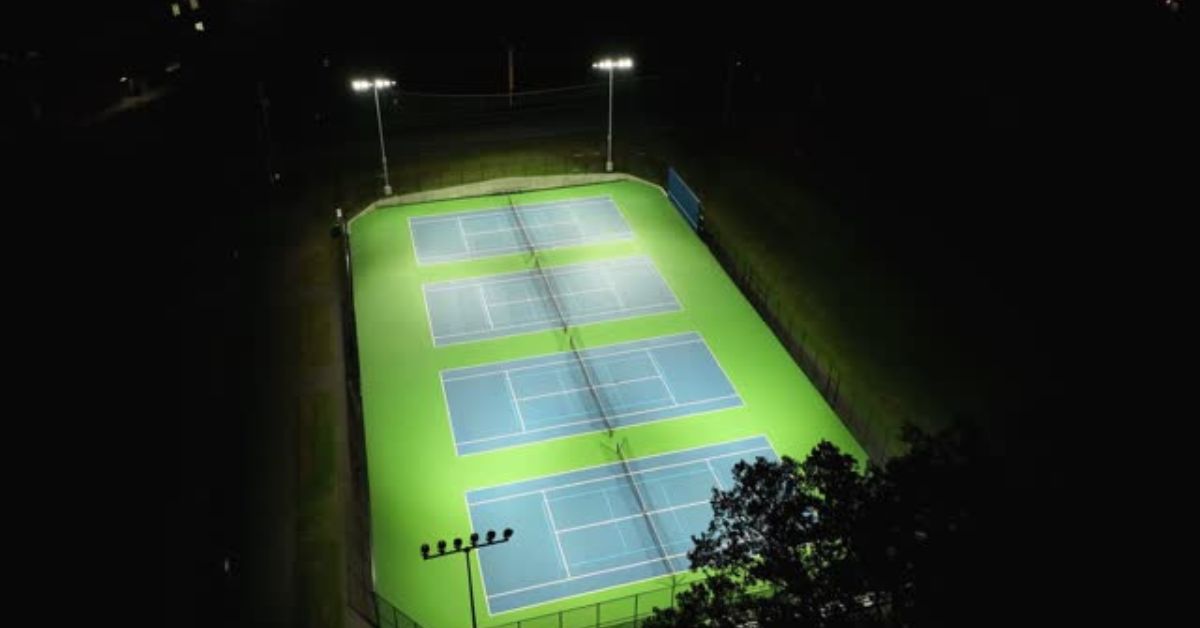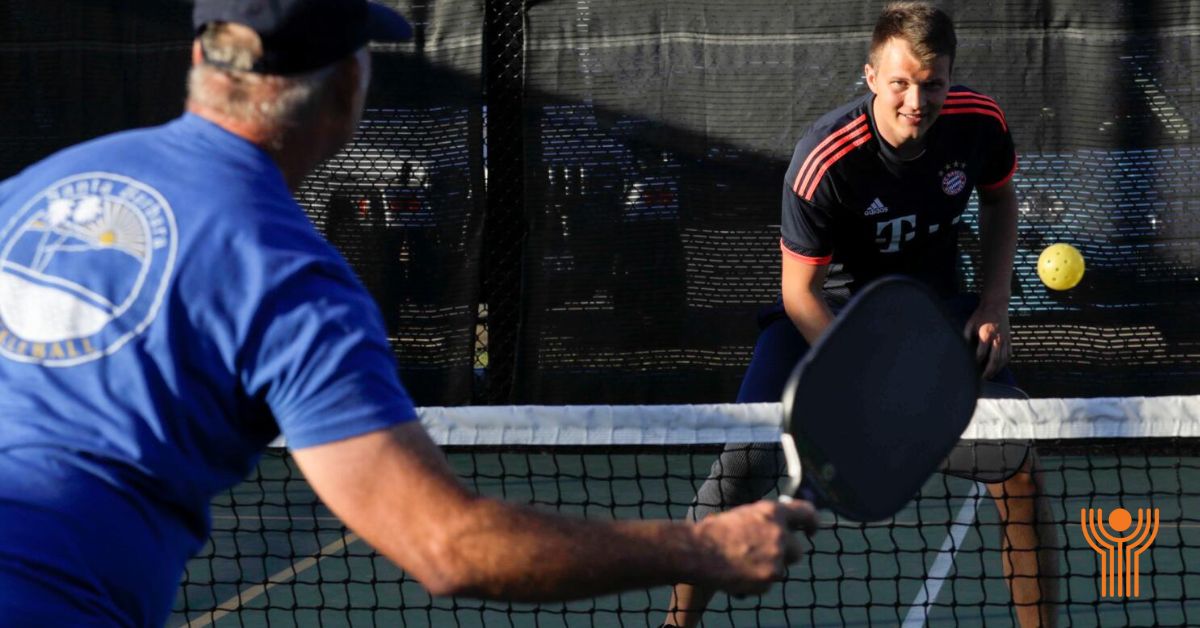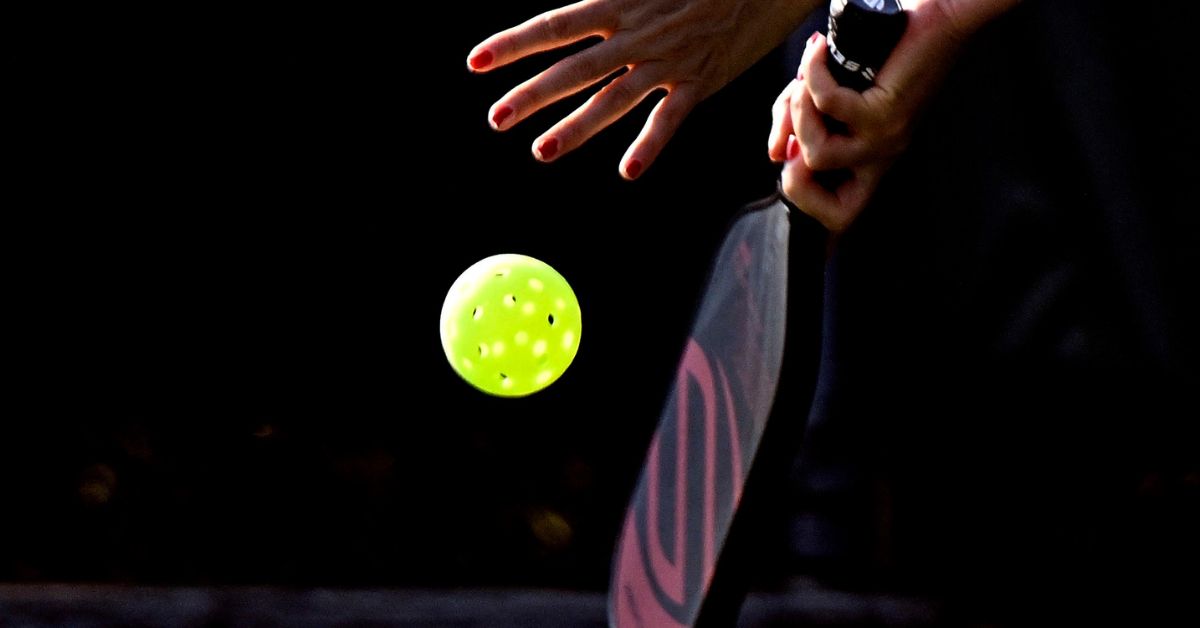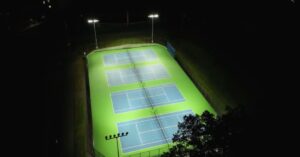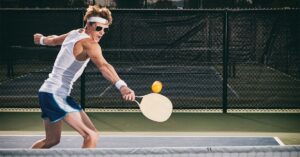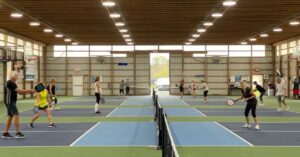Pickleball is a paddle sport with people of all ages hooked on it. From family backyards to competitive arenas, everyone seems eager to try or excel at the sport.
Earlier, we talked about what pickleball is and how it is played, so today, we will take the story a bit further to understand the basic parameters of the pickleball court, i.e., the official pickleball court dimensions.
Understanding the what and why of the court dimensions is a journey into the history and evolution of this dynamic sport. From its humble beginnings on a badminton court to becoming a competitive game regulated by the USA Pickleball Association (USAPA), each court element has a story to tell.
Pickleball Court

So, picture this: back in 1965, when pickleball had just become a thing, its first game went down on a badminton court. And those court dimensions stuck! The official pickleball court dimensions in feet are regulated to be 20 by 44 today for both singles and doubles play, owing to the first time when it was played on a badminton court. The sport provides a unique playing field inspired by tennis, badminton, and ping pong.
Within the rectangular court are assigned zones that define gameplay. Let’s discuss them in detail below:
Centerline
The centerline runs from the middle of the pickleball court. It divides the court into two, and its presence is crucial for maintaining order during gameplay. Serving, volleying, and court positioning ̶ all come down to navigating this central demarcation, which emphasizes the strategic importance of the centerline. An appropriate analogy for this line would be to compare it to the spinal cord in humans.
Right Services Area
On the right side of the centerline lies the right service area. While serving, players must ensure precision in delivering the ball diagonally to the opponent’s left service court. According to the official pickleball rules, the right serving court is where the first serve from each team is played. Then, the server switches between right and left. This area adds an element of strategy, requiring players to master the art of well-placed serves.
Left Services Area
The left service area runs parallel to the right serving court and demands accuracy in serving to the opponent’s right service court. In the pickleball court dimensions, the symmetry in service areas creates a balanced and fair playing field, contributing to the game’s competitive integrity.
Non-Volley Zones
The non-volley zones, commonly known as “the kitchen,” are important for the flow of the gameplay. The kitchen is a 7-foot area on both sides of the net and restricts teams from volleying the ball (hitting it before it bounces) while standing within its boundaries. Through such rules, the kitchen encourages strategic shot selection and controlled gameplay.
The Pickleball Net
The net, an iconic element in any racket sport, stands at 36 inches at the sidelines and 34 inches at the center. Its precise positioning plays a significant role in determining the trajectory of the ball during serves, volleys, and rallies.
Official Pickleball Court Dimensions
As pickleball evolved from a casual backyard game to a competitive sport, the need for standardized court dimensions became apparent. The USA Pickleball Association (USAPA), founded in 2005, took on the responsibility of defining these official dimensions to ensure consistency and fairness in play.
Dimensions Of Different Zones Of The Pickleball Court
When we dissect the pickleball court, each element’s size and position shapes the game’s strategy and flow. Let’s explore the specific measurements that define different aspects of a typical outdoor court:
The centerline, extending from one baseline to the other, acts as the court’s spinal cord, dividing it into two equal halves. It is precisely 22 feet from each sideline, creating a symmetrical layout.
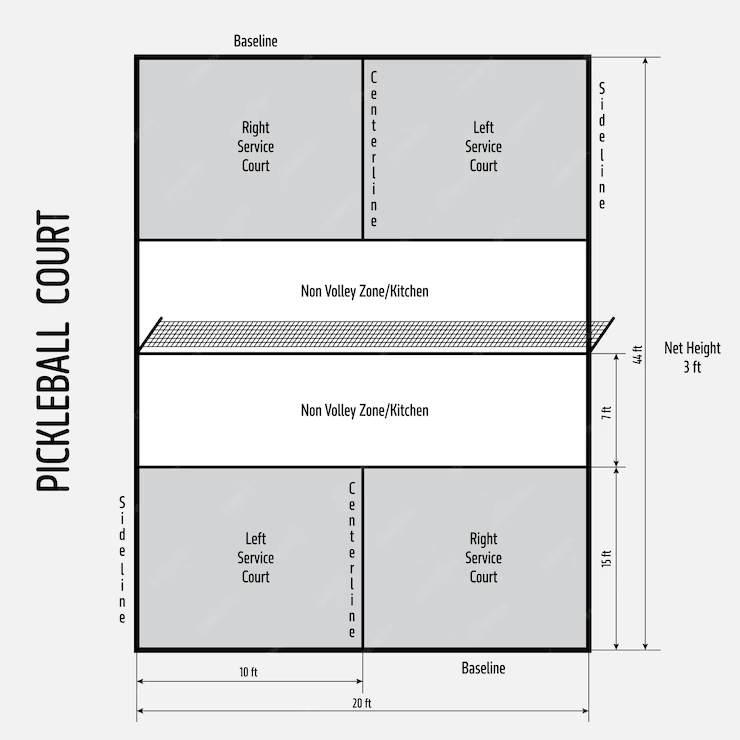
Adjacent to the centerline on both sides, the service area spans from the centerline to either the right or the left sideline. Its width is 10 feet, creating a designated space for serves during gameplay.
The dimensions for the non-volley zones are 7 feet on both sides of the net, creating a distinct area where volleys are prohibited.
Outdoor Pickleball Court Dimensions
While the standard size for a pickleball court is 20 by 44 feet, USAPA recommends having a surface of 30 feet by 60 feet to allow players to play comfortably. This is the standard followed throughout the country for most court sites. A standard size helps players play in different courts without having to adjust much to the location differences.
Backyard Pickleball Court Dimension
Since pickleball is a sport that started in a family backyard, it is still popular amongst families to create small pickleball courts within their homes.
Understanding the official dimensions is critical for enthusiasts looking to enjoy pickleball in their own backyard. Typical backyard pickleball court dimensions run 20 feet by 44 feet, the smallest recommended size for a regulation court. It is recommended to keep 30 feet by 60 feet space assigned to install one court. This allows players to embrace the sport’s essence in a more confined space, fostering accessibility and enjoyment.
Constructing A Pickleball Court
Constructing your own pickleball court is a meticulous process if done right. From land allocation to adhering to USAPA guidelines, selecting court surfacing, exploring DIY options for backyard courts, and optimizing lighting—it involves a lot of processes. Whether you’re a seasoned enthusiast or a casual player, discover the essential steps for bringing the joy of pickleball closer to home.
Allocating Land
The process of constructing a pickleball court begins with a thoughtful consideration of the land. Ideally, a standard court requires a rectangular area with outdoor pickleball court dimensions that run 30 feet by 60 feet, allowing for ample playing space.
It’s crucial to ensure that the chosen land is level and free from significant slopes or irregularities that might affect gameplay. The surface should be even and with robust drainage to maintain a consistent playing experience. Proper land allocation sets the foundation for a court that meets both functional and competitive standards.
USAPA Guidelines
The USA Pickleball Association (USAPA) provides comprehensive guidelines for constructing a pickleball court. These guidelines are designed to standardize pickleball court dimensions, ensuring consistency and fairness in gameplay across different locations.
According to USAPA regulations, a pickleball court runs 20 feet wide and 44 feet long. These dimensions apply to both singles and doubles. The non-volley zones, often referred to as “the kitchen,” are seven feet from the net on both sides. These guidelines serve as a blueprint for constructing a court that aligns with official standards, creating a uniform playing experience for enthusiasts and competitive players alike.
Court Surfacing
The choice of court surfacing is a crucial aspect of construction, influencing the aesthetics and the playing experience. The most common surfacing materials for pickleball courts are asphalt and concrete. Both materials provide a durable and stable foundation, with concrete offering a smoother surface that some players may prefer.
The court surface is required to be free from cracks or any irregularities that may affect gameplay or pose safety risks. Additionally, a reasonably textured finish of the court surface helps enhance traction, preventing slips and ensuring player safety as they move around the court.
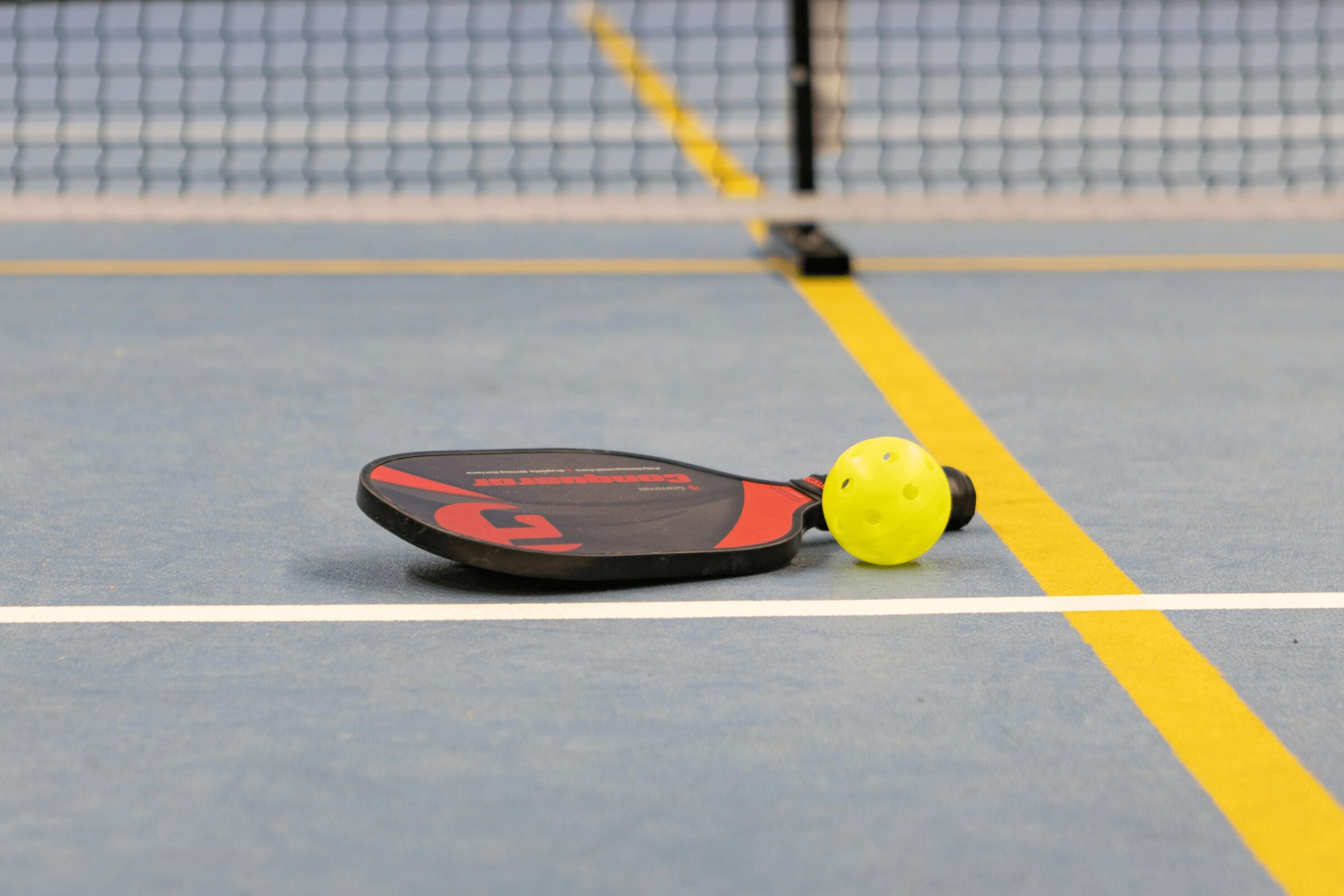
When constructing a pickleball court, selecting the suitable surfacing material is an essential decision that impacts the longevity and quality of the playing surface. Proper maintenance of the court surface, including regular cleaning and resurfacing, is necessary and ensures a fun and smooth playing experience for all.
DIY For Backyard Pickleball Courts
For enthusiasts eager to bring pickleball closer to home, measuring your property for backyard pickleball court dimensions is the first task. The dimensions of a backyard court mirror those of an official pickleball court. The above steps are all relevant to DIY-ing it as long as you know your way around the handyman tools.
While a backyard pickleball court may not replicate the professional courts seen in tournaments, it offers a fantastic opportunity for casual play, practice, and family fun. DIY projects empower enthusiasts to embrace the sport personally, fostering a sense of community and engagement. The passion to develop it later into a career is subjective and not mandatory.
Court Lighting
Proper court lighting is crucial in constructing a pickleball court because of the importance of visibility and extending playtime. Adequate lighting ensures that players can enjoy the game during evenings or low-light conditions, extending the opportunities for play and fostering a vibrant pickleball community.
When planning court lighting, the focus should be on evenly distributing light across the official pickleball court dimensions to minimize shadows and avoid glare. LED lighting is a popular choice for pickleball courts due to its energy efficiency, durability, and clear illumination. Strategic placement of lighting fixtures along the sidelines also helps maintain visibility without causing distractions or hindering gameplay.
Pickleball vs. Tennis Court Dimensions
As mentioned, pickleball rules are inspired by tennis, badminton, and ping pong. It’s not hard to believe then that the pickleball court has also taken inspiration from these courts. We’ve already seen how pickleball dimensions are similar to badminton courts. In this section, we’ll compare pickleball and tennis courts.
The Tennis Court
As per the International Tennis Federation (ITF) rules – the official global tennis network – a tennis court must run at least 27 feet wide and 78 feet long. For a doubles game, the width of the court should be 36 feet.
The baselines and sidelines on a tennis court are similar to the ones in pickleball, running on horizontal and vertical boundaries of the court, respectively. A centerline is also present to divide the court into two. Two additional sidelines are drawn on most tennis courts to allow for both single and double play.
The net in the center of the court is 42 inches high at its posts and 36 inches high in the middle. A service line runs parallel 13.5 feet away from both sides of the net. Between the baseline, sideline, and service line are 2 of the 4 service areas.
In a match, a player serves from beyond the baseline into the diagonally opposite service area of the opponent. A failure to do so results in a wrong service and is flagged as a fault. Two consecutive faults give a point to the opponent.
Pickleball vs. Tennis Court
There are some visible differences between the two courts. First, the pickleball court dimensions are 20 feet wide and 44 feet long, approximately half the size of a tennis court. The tennis court doesn’t have a non-volley zone owing to the fact that volleying is not allowed in tennis at all.
One of the most significant differences, however, is the doubles court, an extended sideline from the singles court. A pickleball court is the same for singles and doubles. For the tennis court, extended sidelines are required to add width for the doubles court.
Repurposing Tennis Courts As Pickleball Courts
If you have access to a tennis court and a desire to enjoy a fast-paced game of pickleball, repurposing the tennis court might be an excellent solution. Given that a standard extended tennis court is 60 feet wide and 120 feet long, there is more than enough space to create multiple pickleball courts within these dimensions. Pickleball court dimensions vs. the tennis court size allow about four pickleball courts on a single tennis court, providing a versatile and cost-effective way to enjoy both sports.

Temporary Pickleball Courts
Pickleball can be set up temporarily on various types of courts, including badminton and basketball courts. However, a tennis court is the most common surface used for shared use. Repurposing tennis courts for pickleball offers a convenient and versatile solution. However, understanding the tennis court and official pickleball court dimensions is essential for the setup.
A Single Pickleball Court Per Tennis Court
The most basic way people repurpose a tennis court like a pickleball court is by drawing pickleball dimensions in the center of the tennis court. The existing infrastructure of the tennis court helps to set up a new court.

A net is already there, albeit different in height. With the advent of portable nets, the tennis net can either be lowered or replaced by a portable pickleball net. The pickleball court dimensions can then be painted or taped on the existing court. USAPA warns to check with the management of the court before drawing lines, of course, but if it’s your own court, you’re the master of it.
USAPA also cautions to consider the orientation of the surface. If the tennis court is set up north to south, you’d rather orient the net north-south than east-west or vice versa to protect your eyes from the sun’s glare.
Two Pickleball Courts Per Tennis Court
If you’re a group of friends eager to get your turn on the court, you can have a couple of outdoor pickleball court dimensions drawn on the tennis court. Here’s how that will work:
You can divide the court into two halves across the tennis net. Since a standard tennis court runs 60 by 120 feet, there are 60 feet of uninterrupted space between the net and the tennis baseline. Therefore, each side of the net can have a pickleball court painted or taped on it such that the service area of the tennis court roughly engulfs the entire non-volley zone of the pickleball court. Refer to the image below for a visual guide.

The choice to either repurpose the tennis net or get portable nets to accommodate more teams depends on you and your party.
Four Pickleball Courts Per Tennis Court
The most space-efficient option while repurposing a tennis court is drawing four pickleball courts. The official pickleball court dimensions allow a maximum of four courts to be constructed on a 60-foot by 120-foot tennis court.
Borrowing from the initial idea of dividing the court into halves across the net continues here. Add to that another division of the court across the centerline. This divides the tennis court into four equal quadrants. Each half can accommodate two pickleball courts, and each quadrant can accommodate a single court such that the sidelines for singles become the centerline for each pickleball court. See the illustration below:

To maximize space and efficiency, repurposing a tennis court to accommodate four pickleball courts is a viable option. Given that a standard tennis court pad is 60’x120′, and the recommended pickleball court dimensions are 30 by 60 feet, it is possible to create four pickleball courts dimensionally within the space of a tennis court. Dividing the tennis court into four equal quadrants and establishing a pickleball court in each quadrant allows for efficient use of the space.
The equivalent of a non-volley zone of pickleball in tennis is the “no man’s land”. The difference between the two is that of dimensions and the fact that “no man’s land” is not the only site on the tennis court where volleying is prohibited.
The centerline in tennis extends from the baseline and only extends to the service line. Therefore, to vertically divide the tennis court in half, you will need to divide the “no man’s land” in two halves vertically. Then, it’s just a matter of setting up portable pickleball nets on each court, and voila! You’ve got four pickleball courts in a single tennis court.
We warn you, though, it may be a little stuffy. But you will have enough space to play comfortably, mostly.
Should You Repurpose An Existing Tennis Court Or Construct A New Pickleball Court
Repurposing a tennis court to accommodate official pickleball court dimensions is a fantastic idea to use space efficiently. If you have access to spare space and relevant knowledge to build a new pickleball court, however, it’s a different game altogether.
You must consider your resources to choose between repurposing an old tennis court or constructing a new pickleball court. There are pros and cons to either of them. A suitable choice for you depends on your purpose.
If you enjoy tennis and have a court, repurposing it can be affordable. It can help you put the space to good use while you’re not playing tennis. Switching between the two is common for amateur people who like to stay entertained on the court.
However, if you want more discipline on the court to prepare for competitions, you ideally need a place dedicated exclusively to tennis or pickleball. Constructing a court from the ground up allows you to orient the court according to the official pickleball court dimensions.
We’d suggest you thoroughly consider your needs and resources to decide between repurposing or constructing a new pickleball court.
Pickleball Court Dimensions: A Legacy Of Its Unique History
Since the sport’s inception in 1965, a lot has changed in pickleball. The sport has left the island it devised on to become the official sport of the state of Washington. It has inspired multiple competitions and tournaments, with thousands of professional players participating to demonstrate their athletic prowess.
One thing that has not changed since 1965 has been the court dimensions of the game. It was played on a 20-foot wide and 44-foot-long badminton court for the first time. And those dimensions have stuck until now!
So that’s all we have to say for the official pickleball court dimensions. Please let us know if you have any questions, want to input our knowledge, or have general comments about the information provided.


